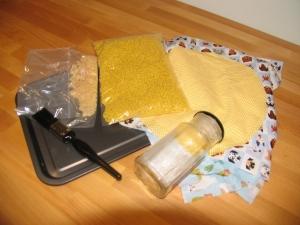Read more : 10 Important Tips to Use Neem Oil for Houseplants
As well as being useful to wrap your own sarnies, these wraps make wonderful, sustainable gifts for friends and family. They can be revived after a couple of months by a few minutes in the oven, wiped with cold water and finally composted at the end of their life!
You can easily make these without the pine resin, but the resin adds a little tackiness which helps the wraps stick to itself like actual clingfilm.
You are watching: How to make your own Beeswax Wraps
Ingredients:
- Beeswax 100% pure and organic, from a sustainable source if possible. A quick online search should bring up lots of suppliers! If you have a block of it, just grate it.
- Pine resin (the crushed crystals seen below – also known as roisin) same sort of stuff used on violin strings. Make sure it’s food-safe. If you can get powdered, that would be easiest.
- Light weight and tightly woven cloth, no stretch, preferably 100% cotton, can use an old shirt even!
- Oil (most people use jojoba if they have it due to its antibacterial properties but a dash of extra-virgin will work well too)
Equipment:
- Deep Saucepan
- Mixing Jar Any reused jar will work though the wider the top the better in order to stir the mixture. (Can be reused every time you make the mixture.)
- Clean Paintbrush To be used only for the mixture. Impossible to clean so use an old one if available.
- Large Baking Tray
- Grease Proof Paper
- Stirrer Like an old chop stick.
 Method:
Method:
- Preheat the oven to around 180 degrees. Bring a pot of water to boil. Measure out the beeswax and pine resin. The 2:1 ratio works well (2 Parts beeswax to 1-part pine resin.)
- Put the beeswax into your glass jar and place that into the boiling water, ensuring no water gets splashed inside it. It can take a while to melt.
- Occasionally stir it and make sure it doesn’t start boiling! Once the wax has mostly melted, add the pine resin a bit at a time. The resin can come lightly crushed, not powdered. If that’s the case, hammering it with a rolling pin can help to break it down and mix it better.
- The pine resin can sometimes gloop together if it doesn’t melt or is added too quickly, being patient and constant stirring and scraping will eventually incorporate it all.
- Once it’s all melted, add the oil (as a general rule of thumb, add 1tsp of oil to every 100g of beeswax used). This is supposed to keep the beeswax pliable but not entirely necessary. Not everyone uses it!
- Place your fabric squares onto greaseproof paper on the baking tray. How large your fabric wrap can be will depend on how large your baking tray is! With your paintbrush, paste the melted mixture onto the fabric, ensuring to cover all of it. You’ll notice where it’s soaked in properly, the fabric will go darker. Place in the oven, for a couple of minutes at a time, until the mixture is soaked in evenly across the fabric. You can paste or sprinkle on more wax if there are any bare patches.
- Once the first square is fully saturated with the wax mixture, if you have an excess of wax, place another fabric square on top to soak it up.
- Drape on a drying rack or hang the soaked square up to dry. It’ll dry very quickly if you hold it between your finger tips (though it’ll be hot!) then you can peg it up to dry entirely. Any wax left on the greaseproof will be soaked up by the next piece of fabric.
Top Tips:
 This can be messy! The wax is hard to clean off kitchen equipment so try to use old stuff if possible and be sure to put down newspaper under the drying area.
This can be messy! The wax is hard to clean off kitchen equipment so try to use old stuff if possible and be sure to put down newspaper under the drying area.- If your wrap cracks, its likely got too much mixture on it. Just place it back in the oven with another clean bit of fabric to soak the excess.
- You should be able to easily bend the fabric and mould it around sandwiches etc with the heat of your hands, pinching the fabric where you want it to stick to itself.
- Use any colourful design you want – these can be great gifts for kids but be aware that the beeswax can turn the fabric slightly yellow, so avoid white if possible.
- You can melt the mixture then pour into moulds and let set. When cooled, these harden and can be grated like beeswax blocks, straight onto fabric before it goes in the oven. Very handy to have on hand for re-waxing and a good idea for any excess mixture you’ve made.
Source: https://gardencourte.com
Categories: Recipe

